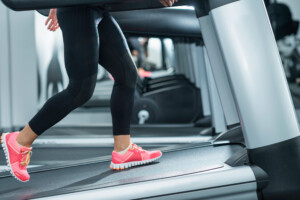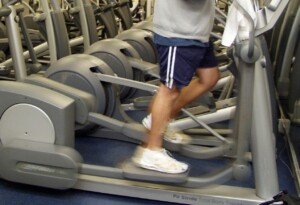
Which is better: HIIT with the elliptical or HIIT with the treadmill?
The best answer to which is better, elliptical HIIT or treadmill HIIT, begins with evaluating your goals. If I had to choose either the treadmill or elliptical for HIIT, I’d go with the treadmill, when asked this question in general.
However, if someone told me he had “bad” knees and couldn’t run, I’d recommend the elliptical for his HIIT sessions, but I’d also see if he could at least do walking HIIT on the treadmill.
High intensity interval training can be done walking. Try walking (not jogging!) 4.5 mph at 15 percent incline without placing your hands anywhere on the treadmill!

Shutterstock/Microgen
This would be your work interval for HIIT, unless you can sustain this for longer than 30 seconds.
If you can, chances are your knees are good enough for some jogging high intensity interval training.
Elliptical HIIT is preferable for people with troublesome knees; knee joint integrity is the big one here, when comparing treadmill HIIT with elliptical. But what about fat-burning?
If you knock yourself out on the elliptical for 30 seconds, such that you can’t go to 31 seconds (your most vicious work interval), and repeat this seven more times, with two minutes of casual recovery pedaling in between, you will burn a tremendous load of calories and fat.
You will also create an after-burn effect: a sped-up resting metabolic rate that may persist for up to 24 hours.
But will this total calorie/fat burn exceed that of a treadmill HIIT session, in which you’re sprinting 12 mph at a slight incline for 30 seconds (because 31 seconds is impossible), for eight cycles total with two minutes’ slow walking in between? I don’t know.
I’d have to do a study involving oxygen consumption testing to find out.
But any kind of sprint-running interval training will blast whopping amounts of fat and cause an extended after-burn.
High intensity interval training on any cardio equipment will have this hormonal effect, increasing production of the fat-burning human growth hormone, be it the elliptical, treadmill (walking, jogging, sprinting), stationary bike, revolving stair case or stair stepper.
The Key…
The key is finding the settings on the equipment that are so rough that going beyond 30 seconds is impossible.

You can set the elliptical machine at resistance level 13 (out of a 1-20 range) and see for how long you can sustain 300 RPMs.
Your first cycle might barely go 30 seconds. But subsequent cycles will be increasingly difficult, and your fifth cycle might be only 15 seconds at 300 RPMs and level 13.
The elliptical machine can be pretty darned difficult if you’re willing to blast away on it.
The caveat is that many people can’t pedal ultra-fast on the elliptical unless they cling onto the rails.
This is cheating because if you hold on, the faster you pedal, the tighter you’ll hold on.
Hands must be completely off the rails while you’re pedaling 300 RPMs. Hands-free will also encourage good posture.
Elliptical HIIT can also be done with slower pedaling, e.g., 180 RPMs, but then you’ll need to crank up the pedal resistance to bring on sheer exhaustion within 30 seconds.
This may be level 15 for some people, and for others, level 9 might do the trick, depending on your fitness level. You can further tweak intensity by altering the pedal angle.
Treadmill HIIT has unique virtues, however; namely, workouts with the treadmill will carry over to real-life movement, either during sports or in daily living, such as sprinting down the street to catch your dog that just got away; sprinting across a parking lot in the rain; and sprinting after the thug who just snatched your purse (assuming you’re not in high heels!).
If your knees are fine, do treadmill HIIT, but throw in some periodic elliptical high intensity interval training so that your body doesn’t become too adapted to the treadmill.
If you prefer the feeling of pedaling over jogging or walking inclines, then aim towards the elliptical, but throw in some here-and-there treadmill HIIT sessions to keep your body guessing.
 Lorra Garrick is a former personal trainer certified through the American Council on Exercise. At Bally Total Fitness she trained women and men of all ages for fat loss, muscle building, fitness and improved health.
Lorra Garrick is a former personal trainer certified through the American Council on Exercise. At Bally Total Fitness she trained women and men of all ages for fat loss, muscle building, fitness and improved health.
.


























